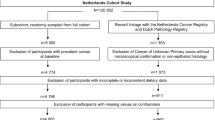Abstract
Objective: To examine the effect of specific dietary carotenoids and their primary plant food sources on lung cancer risk in a population-based case–control study of women. Methods: Data were available for 587 incident primary lung cancer cases and 624 controls frequency matched to cases based on age. A modified version of the 100-item NCI-Block food-frequency questionnaire was used to obtain information concerning usual diet 2–3 years prior to interview. Results: In models adjusted for age, total calorie intake, pack-years of smoking, and education, β-carotene, β-cryptoxanthin, lutein + zeaxanthin, and total carotenoid intake were each associated with a significantly lower risk of lung cancer. Several vegetable groups were predictive of lower lung cancer risk, particularly the frequency of total vegetable intake. Individual and total carotenoids were no longer significantly associated with lower lung cancer risk in models adjusted for total vegetable intake. However, total vegetable intake remained significantly inversely associated with risk in models adjusted for total carotenoids. Conclusions: These results indicate that consumption of a wide variety of vegetables has a greater bearing on lung cancer risk in a population of smoking and nonsmoking women than intake of any specific carotenoid or total carotenoids.
Similar content being viewed by others
References
Greenlee RT,Hill-Harmon MB,Murray T,Thun M (2001) Cancer statistics, 2001. CA Cancer J Clin 51: 15-36.
Ziegler RG,Mayne ST,Swanson CA (1996) Nutrition and lung cancer. Cancer Causes Control 7: 157-177.
Rock CL (1997) Carotenoids: biology and treatment. Pharmacol Ther 75: 185-197.
Alpha-Tocopherol and Beta-Carotene Cancer Prevention Study Group(1994) The effect of vitamin E and beta carotene on the incidence of lung cancer and other cancers in male smokers. The Alpha-Tocopherol, Beta Carotene Cancer Prevention Study Group. N Engl J Med 330: 1029-1035.
Omenn GS,Goodman GE,Thornquist MD, et al. (1996) Effects of a combination of beta carotene and vitamin A on lung cancer and cardiovascular disease. N Engl J Med 334: 1150-1155.
Michaud DS,Feskanich D,Rimm EB, et al. (2000) Intake of specific carotenoids and risk of lung cancer in 2 prospective US cohorts. Am J Clin Nutr 72: 990-997.
Knekt P,Jarvinen R,Teppo L,Aromaa A,Seppanen R (1999) Role of various carotenoids in lung cancer prevention. J Natl Cancer Inst 91: 182-184.
Ziegler RG,Colavito EA,Hartge P, et al. (1996) Importance of alpha-carotene, beta-carotene, and other phytochemicals in the etiology of lung cancer. J Natl Cancer Inst 88: 612-615.
Le Marchand L,Hankin JH,Kolonel LN,Beecher GR,Wilkens LR,Zhao LP (1993) Intake of specific carotenoids and lung cancer risk. Cancer Epidemiol Biomarkers Prev 2: 183-187.
Garcia-Closas R,Agudo A,Gonzalez CA,Riboli E (1998) Intake of specific carotenoids and flavonoids and the risk of lung cancer in women in Barcelona, Spain. Nutr Cancer 32: 154-158.
Voorrips LE,Goldbohm RA,Brants HA, et al. (2000) A prospective cohort study on antioxidant and folate intake and male lung cancer risk. Cancer Epidemiol Biomarkers Prev 9: 357-365.
Candelora EC,Stockwell HG,Armstrong AW,Pinkham PA (1992) Dietary intake and risk of lung cancer in women who never smoked. Nutr Cancer 17: 263-270.
Alavanja MC,Lubin JH,Mahaffey JA,Brownson RC (1999) Residential radon exposure and risk of lung cancer in Missouri. Am J Public Health 89: 1042-1048.
Swanson CA,Brown CC,Sinha R,Kulldorff M,Brownson RC,Alavanja MC (1997) Dietary fats and lung cancer risk among women: the Missouri Women's Health Study (United States). Cancer Causes Control 8: 883-893.
Alavanja MC,Brownson RC,Berger E,Lubin J,Modigh C (1996) Avian exposure and risk of lung cancer in women in Missouri: population based case-control study. BMJ 313: 1233-1235.
Block G,Hartman AM,Dresser CM,Carroll MD,Gannon J,Gardner L (1986) A data-based approach to diet questionnaire design and testing. Am J Epidemiol 124: 453-469.
Smucker R,Block G,Coyle L,Harvin A,Kessler L (1989) A dietary and risk factor questionnaire and analysis system for personal computers. Am J Epidemiol 129: 445-449.
Chug-Ahuja JK,Holden JM,Forman MR,Mangels AR,Beecher GR,Lanza E (1993) The development and application of a carotenoid database for fruits, vegetables, and selected multicomponent foods. J Am Diet Assoc 93: 318-323.
Panel on Dietary Antioxidants and Related Compounds, Food and Nutrition Board, Institute of Medicine(2000) Dietary Reference Intakes for Vitamin C, Vitamin E, Selenium, and Carotenoids. Washington, DC: National Academy Press.
Comstock GW,Alberg AJ,Huang HY, et al. (1997) The risk of developing lung cancer associated with antioxidants in the blood: ascorbic acid, carotenoids, alpha-tocopherol, selenium, and total peroxyl radical absorbing capacity. Cancer Epidemiol Biomarkers Prev 6: 907-916.
Yuan JM,Ross RK,Chu XD,Gao YT,Yu MC (2001) Prediagnostic levels of serum beta-cryptoxanthin and retinol predict smoking-related lung cancer risk in Shanghai, China. Cancer Epidemiol Biomarkers Prev 10: 767-773.
Feskanich D,Ziegler RG,Michaud DS, et al. (2000) Prospective study of fruit and vegetable consumption and risk of lung cancer among men and women. J Natl Cancer Inst 92: 1812-1823.
Voorrips LE,Goldbohm RA,Verhoeven DT, et al. (2000) Vegetable and fruit consumption and lung cancer risk in the Netherlands Cohort Study on diet and cancer. Cancer Causes Control 11: 101-115.
National Center for Chronic Disease Prevention and Health Promotion(2001) Behavioral Risk Factor Surveillance System, Year 2000. Survey data. Centers for Disease Control and Prevention, US Department of Health and Human Services.
Author information
Authors and Affiliations
Corresponding author
Rights and permissions
About this article
Cite this article
Wright, M.E., Mayne, S.T., Swanson, C.A. et al. Dietary carotenoids, vegetables, and lung cancer risk in women: the Missouri Women's Healty Study (United States). Cancer Causes Control 14, 85–96 (2003). https://doi.org/10.1023/A:1022565601937
Issue Date:
DOI: https://doi.org/10.1023/A:1022565601937




